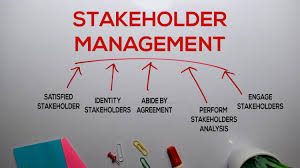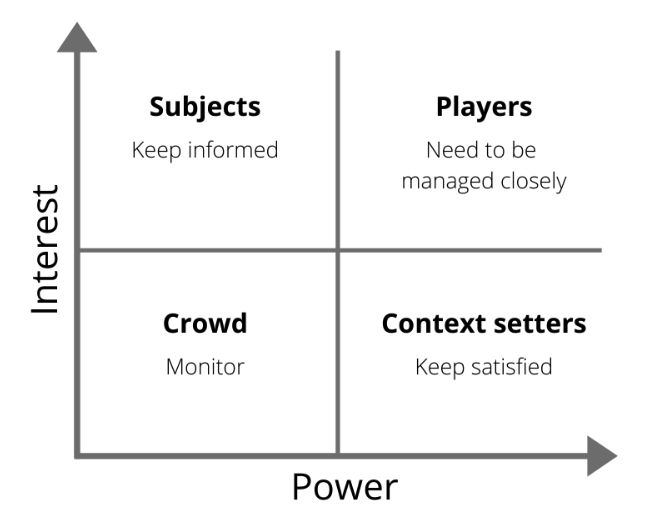
Bringing the right stakeholders together and effective stakeholder management are essential requirements for leading a project to success. In Agile/Scrum, how can we identify the right stakeholders and ensure we are informing them at the rate/type of information they want?. This article attempts to answer these questions by discussing how to identify the right stakeholders and manage them effectively.
Stakeholder Identification
First, to identify the stakeholders, answer the simple question of what type of people you want to involve in your project from development to production release with the allocated budget and timeline? The stakeholders in Agile/Scrum typically include interested parties other than the scrum master, developers, and product owners such as customers, department heads, senior managers, executives, and representatives from units like operations, sales, marketing, legal, and finance. However, depending on the type of project or product, you can include different types of representatives from other departments as stakeholders.
When identifying the right stakeholders, choose people who have a genuine interest over people with a vested interest in the projects. They view the entire project from an organization's perspective rather than a personal perspective. It is better to consider stakeholders who can clear obstacles and eliminate stakeholders who can potentially slow down your deliveries. Particularly the stakeholders need to be people who can provide a voice for your ideas and lead opinions. Moreover, in an Agile setting, it is essential to involve external stakeholders from IT support, networking, and databases teams for production support.
Suppose you cannot decide on which stakeholders you need in your project. In that case, you can do a stakeholder analysis using Ackermann and Eden’s power-interest grid technique, as illustrated below.

This stakeholder analysis technique considers the stakeholder interests and power in assessing the stakeholder type assuming that the stakeholders have high and low interest and power.
- It shows that if the stakeholder has low interest and high power, they are known as ‘players’ of the team. You need to collaborate closely for important tasks in the product lifecycle, such as product strategy and road map creation.
- Stakeholders with high power but low interest are known as ‘context setters’ who can impact product context even if they have low interest in the product. One example of such a stakeholder is the person that manages the dev team and has the power to provide adequate dev resources to satisfy the estimated dev capacity. Still, they do not want to get directly involved in the project.
- Stakeholder with low power but high interest is known as ‘subjects ’ who are keen on your product but has less power to change decisions. You need to involve them regularly in important meetings and get their feedback. However, you need to assess if their idea is acceptable or not based on the product strategy and roadmap.
- The last stakeholder type you need to identify is the ‘crowd’ who have low interest and low power to influence your decisions, but you need to keep always informed about the project. For example, sharing the project milestones and related designs and articles.
Stakeholder Management
Once you have identified and analyzed the stakeholders, the next step is effectively engaging them to get the best possible outcome. A large project to manage, ineffective communication, and vested interests are key barriers to stakeholder management.
1. Involve Stakeholders from the early phases of the project
Stakeholder participation from the early phases of the project is important to establish the project expectations and identify the individual expectations. Encourage them to participate in regular meetings, discussions, and activity sessions to foster a sense of inclusivity and increase their morale.
2. Avoid pleasing or forcing stakeholders but lead them to what you want
Stakeholder opinions, decisions, and feedback are of utmost value to delivering a quality product at the end of the product life cycle. Two types of people can negatively affect the stakeholder management process. The first type of people can always try to get the side of stakeholders even if their decisions are not right to please them. This can lead to products of poor quality and value to the customers. On the other hand, some people can force stakeholders to agree with their decisions and opinions. Consequently, the project will never harbor the fullest knowledge and expertise of stakeholders. Thus, eliminate these two approaches and embrace the culture of treating them as equal counterparts accepting only the right attitude
3. Be open-minded and earn the individuals’ trust
Earn the trust of stakeholders to lead the project in the right direction because when they trust you, they will eventually follow your lead and support you to achieve the project goals. But, how can you build this trust? Attentive listening is one way you can build trust. If they know you are actively listening rather than pretending to do so, this cultivates a sense of inclusion in their mind. Try to understand their ideas, concerns, and opinions open-mindedly without judging them in the first place.
4. Collaborate effectively
Effective communication and collaboration are key requirements in stakeholder management. Promote collaboration in the early phases of the project planning, such as in release planning to communicate what needs to be done and set expectations. It will help identify the dependencies, priorities, and risks as early as possible to avoid any project failures. Also, when communicating with them, it is important to do so with clarity without any ambiguity. Encourage continuous communication and feedback using both verbal and written communication methods keeping everyone in the loop so that everyone has up-to-date information.
5. Formulate stakeholder groups
The stakeholder's assignment to a project can change over time because they can change positions, join new ventures, etc. Thus, evolve the stakeholders into a group where they can support new stakeholders that join in the future easily groom up to the expected level. Organize workshops to bridge the skill gaps, clearly define the roles and responsibilities of individuals within such teams, and help address their issues and concerns. Such organized stakeholder groups help everyone quickly address the challenges of individuals, work more efficiently, and increase productivity.
Summary
Stakeholders are the key people that drive an Agile/Scrum project to achieve its defined goal. The collection of stakeholders can make or break the projects’ intended objectives. This article described different ways to identify the right stakeholders, including a popular analysis technique to identify the type of stakeholders. Next, the article discussed an important topic: how to manage them to harness the best possible results. We believe the points discussed in this article will guide you to the right stakeholder identification and management to lead your projects to success.